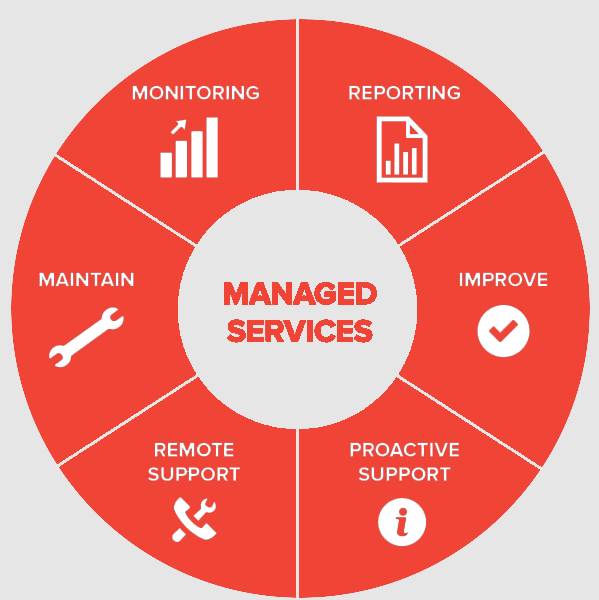
In today’s digital workplace, every organization depends heavily on its IT infrastructure — from email systems and business applications to servers and cloud platforms. When something goes wrong, it doesn’t just disrupt one person’s work; it can slow down or even halt entire departments.
Traditionally, IT support has focused on fixing problems after they happen. A user sends a ticket, a technician responds, and the issue gets resolved. But as companies grow and become more reliant on technology, this reactive approach often leads to costly downtime, lost productivity, and growing support backlogs.
The smarter approach? Proactive remote support — a way of monitoring and managing IT systems to prevent problems before they ever start.

What is Proactive Remote Support?
Proactive remote support is a modern IT strategy that combines remote access tools with ongoing monitoring, automation, and system maintenance. Instead of waiting for users to report issues, IT teams can:
- Monitor systems 24/7
- Detect potential issues early
- Perform regular maintenance remotely
- Automate tasks to reduce human error
In simple terms, it’s like having a digital IT team watching over your devices and systems at all times — ready to act before things go wrong.

Why Proactive Support Matters More Than Ever
Here’s what often happens in a reactive IT support environment:
- A user’s device crashes unexpectedly during an important meeting.
- A system update gets missed, leaving the business vulnerable to cyber threats.
- A server runs out of space, causing applications to crash.
By the time the issue is noticed, productivity is already affected, and valuable time is spent fixing the problem.
Now imagine this:
- A remote support system detects aa storage issue in advance and clears space overnight.
- A patch is pushed remotely to all systems as soon as a vulnerability is discovered.
- A failing hard drive is flagged, and replaced before it causes downtime.
That’s the power of proactive support — it turns IT from a firefighter into a forward planner.
How Remote Support Enables Proactive IT Management
1. Real-Time Monitoring and Alerts
Modern remote support platforms allow IT teams to monitor:
- Device health (CPU, memory, storage)
- Network performance
- Security events (e.g. unauthorized login attempts)
- Application errors
When something abnormal happens, the system automatically alerts the IT team — enabling instant response without waiting for users to report it.
2. Automated Updates and Maintenance
Routine tasks like:
- Operating system updates
- Antivirus scans
- Disk cleanup
- Software patches
Can be scheduled or triggered remotely. This ensures that every device is always up to date, secure, and performing optimally — with minimal user disruption.
3. Remote Troubleshooting and Fixes
When an issue is identified, technicians can use remote desktop tools (like AnyDesk, Zoho Assist, TeamViewer, or Splashtop) to:
- Log into the affected system
- Diagnose the problem
- Apply a fix in real-time
No need for physical visits, scheduling delays, or downtime.
4. Predictive Maintenance
Some advanced tools use AI or machine learning to identify patterns. For example:
- A server that’s been slowly heating up may indicate a fan failure coming soon.
- A device with growing disk errors may be headed toward a crash.
These insights help IT teams take action early — extending hardware life and avoiding surprise failures.
Benefits Of Proactive Remote Support
1. Reduced Downtime
By identifying and fixing issues before they escalate, businesses avoid unnecessary system crashes and user frustration.
2. Higher Productivity
When systems run smoothly, employees can stay focused on their work — without waiting for IT support or dealing with slow computers.
3. Stronger Cybersecurity
Proactive patching, monitoring, and endpoint protection help close security gaps before attackers can exploit them.
4. Lower Support Costs
IT teams spend less time fixing emergencies and more time optimizing systems. Over time, this reduces labor costs and extends the life of equipment.
5. Better IT Planning
With real-time reports and insights, businesses can plan for upgrades, budgeting, and staffing — rather than reacting to surprises.
Getting Started With Proactive Remote Support
Here’s how your business can implement a proactive approach:
1. Choose the Right Remote Support Tools
Look for platforms that offer:
- 24/7 monitoring
- Remote desktop access
- Automated task scheduling
- Security alerts and reporting
- Cross-platform support (Windows, Mac, mobile)
2. Set Monitoring Standards
Decide what you want to track. Common areas include:
- CPU and memory usage
- Disk health and space
- Software update status
- Backup completion
Set thresholds for alerts so that the IT team is notified before a problem happens.
3. Automate What You Can
Schedule:
- Antivirus scans
- Patch deployments
- System cleanups
The more you automate, the less time your team spends on manual tasks — and the fewer things fall through the cracks.
4. Educate Your Team
Even with proactive tools, end users are still your first line of defense. Train them to:
- Report unusual behavior quickly
- Avoid suspicious links or downloads
- Understand basic maintenance (like restarting their computers)
5. Review and Optimize Regularly
Use reports and metrics to review how your systems are performing and where improvements can be made. IT support should evolve with your business.
Overcoming Common Concerns
“Is remote access secure?”
Yes — most remote support tools use encrypted connections, two-factor authentication, and session logging to ensure safety and compliance.
“What about user privacy?”
Access can be limited to specific devices, times, or user permissions. Many tools notify users when a technician connects.
“Do we need a big IT team for this?”
Not at all. Proactive support actually reduces workload. In fact, it helps small teams manage large networks more effectively.
Conclusion: Stay Ahead, Not Behind
Proactive remote support is no longer a luxury — it’s a necessity for modern businesses. It’s about staying ahead of IT issues instead of constantly putting out fires.
By using the right tools and mindset, your business can:
- Prevent problems before they impact work
- Reduce downtime and support costs
- Improve user experience
- Strengthen your IT security
It’s time to move from reactive support to a proactive, remote-first IT strategy — and create a smoother, smarter, and more reliable digital workplace.
